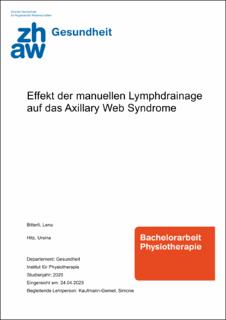Please use this identifier to cite or link to this item:
https://doi.org/10.21256/zhaw-31008Full metadata record
| DC Field | Value | Language |
|---|---|---|
| dc.contributor.advisor | Kaufmann-Gernet, Simone | - |
| dc.contributor.author | Bitterli, Lena | - |
| dc.contributor.author | Hitz, Ursina | - |
| dc.date.accessioned | 2024-07-09T09:43:57Z | - |
| dc.date.available | 2024-07-09T09:43:57Z | - |
| dc.date.issued | 2023 | - |
| dc.identifier.uri | https://digitalcollection.zhaw.ch/handle/11475/31008 | - |
| dc.description.abstract | Hintergrund : Das Axillary Web Syndrome ist eine häufig auftretende Komplikation nach einer Brustkrebsoperation. Das Krankheitsbild ist geprägt durch straffe Stränge im Achsel- und Armbereich und schränkt Betroffene im Alltag ein. Die Pathophysiologie des Axillary Web Syndrome ist nicht vollständig geklärt und daher besteht noch kein optimaler Therapieansatz. Eine mögliche physiotherapeutische Intervention ist die manuelle Lymphdrainage. Ziel : Die vorliegende Literaturarbeit untersuchte den Effekt der manuellen Lymphdrainage auf das Axillary Web Syndrome nach Brustkrebsoperationen. Der Effekt wurde anhand der Dauer und Intensität der Symptome eines Axillary Web Syndrome, bezüglich der Parameter Schmerz, Schulterfunktion und Lebensqualität gemessen. Methode In medizinischen Datenbanken wurde nach geeigneter Literatur recherchiert. Die Resultate der Studien wurden zusammengetragen und mit der PEDro-Skala sowie dem Critical Appraisal Skills Programme kritisch gewürdigt. Ergebnisse : Ein Axillary Web Syndrome-spezifisches Physiotherapieprogramm kombiniert mit manueller Lymphdrainage reduziert in den ersten drei Monaten schnell und wirksam die Schmerzen und verbessert die Schulterfunktion. Dadurch kann eine Verbesserung der körperlichen und funktionellen Aspekte der Lebensqualität bei Betroffenen mit einem Axillary Web Syndrome erzielt werden. Schlussfolgerung : Die Ergebnisse belegen, dass ein Axillary Web Syndrome-spezifisches Physiotherapieprogramm in Kombination mit der manuellen Lymphdrainage somit ein wichtiger Bestandteil der frühen Behandlung eines Axillary Web Syndrome ist. | de_CH |
| dc.description.abstract | Background : The axillary web syndrome is a common complication after breast cancer surgery. It is characterized by tight cords in the axilla and arm area and reduces quality of life. The pathophysiology and the most effective treatment option of the axillary web syndrome have not been fully investigated. Manual lymphatic drainage is one possible physical therapy intervention. Aim : This literature review investigated the effect of manual lymphatic drainage on the axillary web syndrome after breast cancer surgery. The effect on the intensity and duration of the axillary web syndrome symptoms was evaluated regarding the parameters pain, shoulder dysfunction and quality of life. Method : The systematic research was conducted in different medical databases. The results of the studies were summarized and critically appraised using the PEDro scale and the Critical Appraisal Skills Programme. Results : An axillary web syndrome-specific physical therapy program combined with manual lymphatic drainage reduces pain quickly and effectively and improves shoulder function within the first three months. An improvement in physical and functional aspects of quality of life can be achieved. Conclusion : An axillary web syndrome-specific physical therapy program combined with manual lymphatic drainage is an important component in the early treatment of the axillary web syndrome. | de_CH |
| dc.format.extent | 130 | de_CH |
| dc.language.iso | de | de_CH |
| dc.publisher | ZHAW Zürcher Hochschule für Angewandte Wissenschaften | de_CH |
| dc.rights | https://creativecommons.org/licenses/by/4.0/ | de_CH |
| dc.subject | Axillary Web Syndrome | de_CH |
| dc.subject | Brustkrebs | de_CH |
| dc.subject | Modalitäten der Physiotherapie | de_CH |
| dc.subject | Manuelle Lymphdrainage | de_CH |
| dc.subject | Schmerz | de_CH |
| dc.subject | Schulterdysfunktion | de_CH |
| dc.subject | Lebensqualität | de_CH |
| dc.subject | Breast neoplasms | de_CH |
| dc.subject | Physical therapy modalities | de_CH |
| dc.subject | Manual lymphatic drainage | de_CH |
| dc.subject | Pain | de_CH |
| dc.subject | Shoulder dysfunction | de_CH |
| dc.subject | Quality of life | de_CH |
| dc.subject.ddc | 615.82: Physiotherapie | de_CH |
| dc.title | Effekt der manuellen Lymphdrainage auf das Axillary Web Syndrome | de_CH |
| dc.type | Thesis: Bachelor | de_CH |
| dcterms.type | Text | de_CH |
| zhaw.departement | Gesundheit | de_CH |
| zhaw.publisher.place | Winterthur | de_CH |
| dc.identifier.doi | 10.21256/zhaw-31008 | - |
| zhaw.originated.zhaw | Yes | de_CH |
| Appears in collections: | Abschlussarbeiten Physiotherapie | |
Files in This Item:
| File | Description | Size | Format | |
|---|---|---|---|---|
| 2023_Bitterli-Lena_Hitz-Ursina_BA_PT20_Version2.pdf | 13.44 MB | Adobe PDF |  View/Open |
Show simple item record
Bitterli, L., & Hitz, U. (2023). Effekt der manuellen Lymphdrainage auf das Axillary Web Syndrome [Bachelor’s thesis, ZHAW Zürcher Hochschule für Angewandte Wissenschaften]. https://doi.org/10.21256/zhaw-31008
Bitterli, L. and Hitz, U. (2023) Effekt der manuellen Lymphdrainage auf das Axillary Web Syndrome. Bachelor’s thesis. ZHAW Zürcher Hochschule für Angewandte Wissenschaften. Available at: https://doi.org/10.21256/zhaw-31008.
L. Bitterli and U. Hitz, “Effekt der manuellen Lymphdrainage auf das Axillary Web Syndrome,” Bachelor’s thesis, ZHAW Zürcher Hochschule für Angewandte Wissenschaften, Winterthur, 2023. doi: 10.21256/zhaw-31008.
BITTERLI, Lena und Ursina HITZ, 2023. Effekt der manuellen Lymphdrainage auf das Axillary Web Syndrome. Bachelor’s thesis. Winterthur: ZHAW Zürcher Hochschule für Angewandte Wissenschaften
Bitterli, Lena, and Ursina Hitz. 2023. “Effekt der manuellen Lymphdrainage auf das Axillary Web Syndrome.” Bachelor’s thesis, Winterthur: ZHAW Zürcher Hochschule für Angewandte Wissenschaften. https://doi.org/10.21256/zhaw-31008.
Bitterli, Lena, and Ursina Hitz. Effekt der manuellen Lymphdrainage auf das Axillary Web Syndrome. ZHAW Zürcher Hochschule für Angewandte Wissenschaften, 2023, https://doi.org/10.21256/zhaw-31008.
Items in DSpace are protected by copyright, with all rights reserved, unless otherwise indicated.